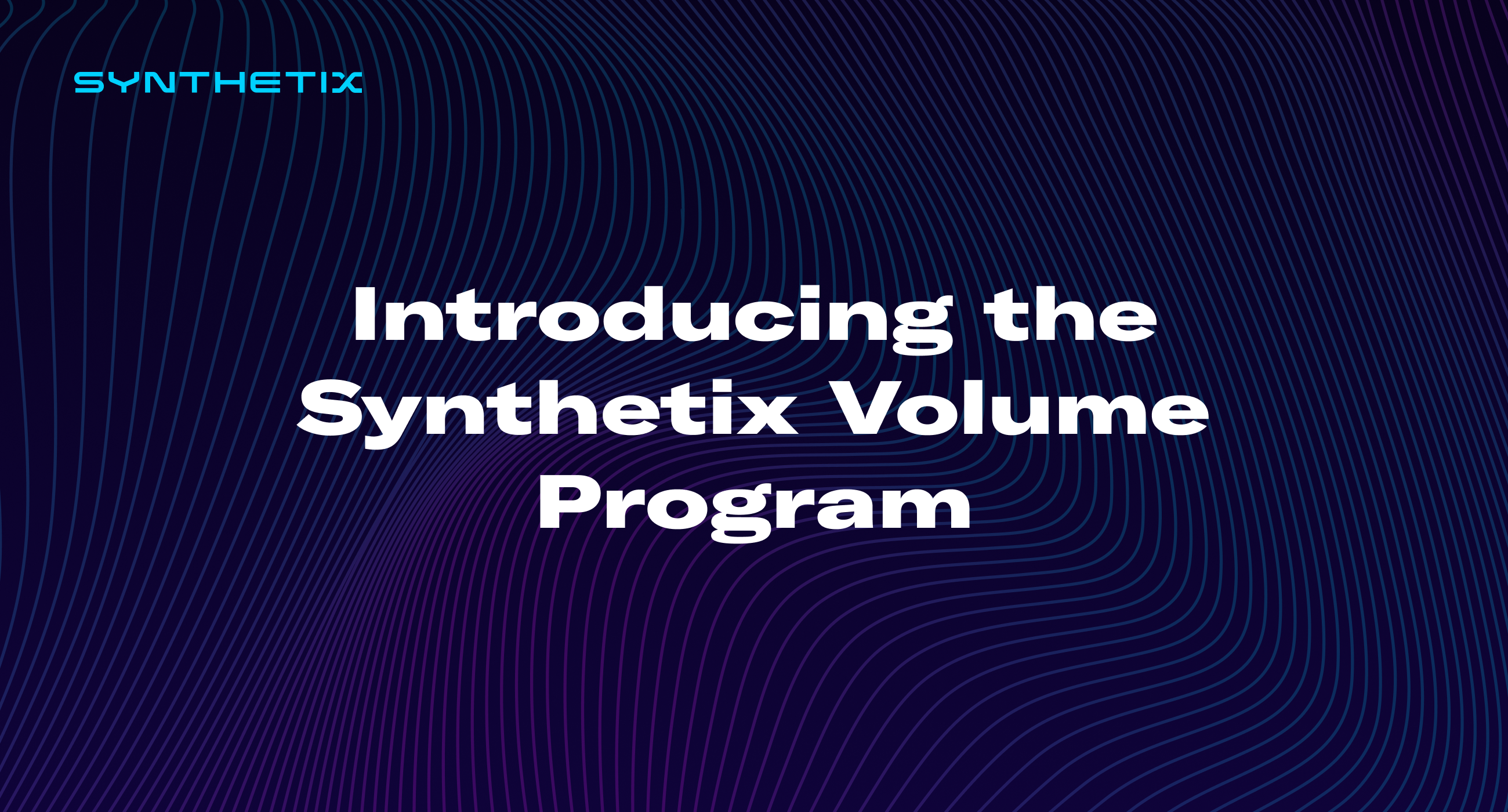The Synthetix Volume Program
The new program incentivising Synth trading volume across DeFi

The synthetixDAO is excited to announce a new initiative designed to incentivize native integration of the Synthetix protocol across DeFi platforms and protocols. This program will pay a fee rebate to approved integrators who implement Synth exchanging natively and generate protocol exchange volume through their interfaces.
Program details
The program will run as a trial for three months initially, and then based on feedback from participants, will be formalized into an ongoing program. This program will be separate and in addition to the upcoming trading incentives covered by SIP-63.
The structure of the program is as follows:
- The program launched Midnight UTC on the 1st September 2020
- 25% of the net fees paid will be rebated
- Rebates will be paid in SNX
- Three-month trial
- Capped at 100k SNX per month during the trial
- The cap may be raised at our discretion
- If the cap is hit rebates will be distributed pro-rata
- You must run a consumer-facing DeFi protocol, app, or website.
- You must fill out the application form here: Volume Program Application
- Once approved you will receive a referral code that must be included in all transactions
Volume Program Members
We are excited to have several top DeFi projects already integrated for the launch with more coming soon. The initial Volume Program members are:
Example integrations
All Synths like sBTC (synthetic bitcoin) and sXAU (synthetic gold) have a special property that allows them to be converted between each other at the current spot price via the Synthetix contracts. This section of the docs provides a contract call level flow of this process for engineers. In order to qualify for the program you need to implement Synth exchanging via the Synthetix contracts.
Example 1
Alice has built a popular mobile wallet that allows users to interact with various DeFi dApps. She has built a native integration into Uniswap, Curve and Balancer so that when a user wants to convert ETH to KNC the mobile app will route the trade through Uniswap or Balancer depending on which has the best price. If a user wants to swap sUSD to LEND the same process occurs the app looks for the best price on the trade and sends the order to Balancer or Uniswap. Now if a user wants to trade sUSD for sBTC, two Synths issues by the Synthetix protocol, this trade would likely be routed through Balancer, but there would be considerable slippage. So Alice decides to implement a specific function for Synth swaps that bypasses the normal liquidity pools and goes straight to the Synthetix contracts. Now when a user tries to trade sUSD to sBTC the app calls exchange on Synthetix and the conversion occurs directly between the Synths with zero slippage. If Alice had successfully applied for the volume rebate program and the USD value of this trade was $10,000 this exchange would accrue a rebate of $7.50 (25% of the $30 protocol fee).
Example 2
Carol runs a successful DeFi yield aggregation dApp that allows users to move between protocols to capture the best yield. She hears about a new incentives trial by Synthetix where depositing sBTC (synthetic bitcoin) into curve and staking it in Mintr will be paid SNX incentives. She implements a system to help users migrate in one transaction from any of the other Synthetix incentives into this new one. One popular path is a shift from the iETH (inverse or short Ether Synthetic asset) incentive to this new sBTC incentive. Carol decides to make this conversion as simple and cheap as possible, so she implements an exchange between iETH and sBTC at the contract level rather than routing through a popular liquidity pool. One of her users, a large DeFi yield farming whale has $1m USD in the iETH incentive and wants to get into this new sBTC incentive. Carol’s dApp unstakes the iETH and then calls exchange on the Synthetix contracts to convert the iETH directly into sBTC, the most efficient path between those two assets. The dApp then automatically deposits the sBTC into the Curve pool and stakes it in Mintr. This direct conversion of of $1m in iETH to sBTC generates a Synthetix protocol fee of $3,000 occurring a rebate for Carol of $750.
Example 3
Isobel runs a centralized exchange with many users suddenly interested in getting exposure to gold and silver. She hears about sXAU (synthetic gold) and sXAG (synthetic silver) and decides to add them to her exchange. To make it easier for users to get access to these tokens with minimal slippage she decides to create a USDT to gold/silver button on the site. Each time a user buys gold or silver for USDT in the background her exchange goes to curve and converts USDT into sUSD, the next step is to use the Synthetix contracts to exchange the sUSD to sXAU, so her platform calls exchange between sUSD and sXAU via the Synthetix protocol and the sUSD is converted to sXAU. From the perspective of the user they simply see a conversion between USDT and Gold and they now have 5 ounces of synthetic gold on Isobel’s exchange. This conversion of ~$10,000 USD generates a rebate of around $30 for Isobel’s exchange.
These are just a few examples of direct integrations of the Synthetix protocol to improve user experience on almost any crypto platform. The key component is that the exchange of Synths must happen using the Synthetix contracts.
Get Started
You can apply to become a Volume Program member by filling out our Volume Program Application Form.
For detailed integration documents, visit docs.synthetix.io.
For more information on the program and integrations generally please reach out on Discord or email integrations@synthetix.io.

